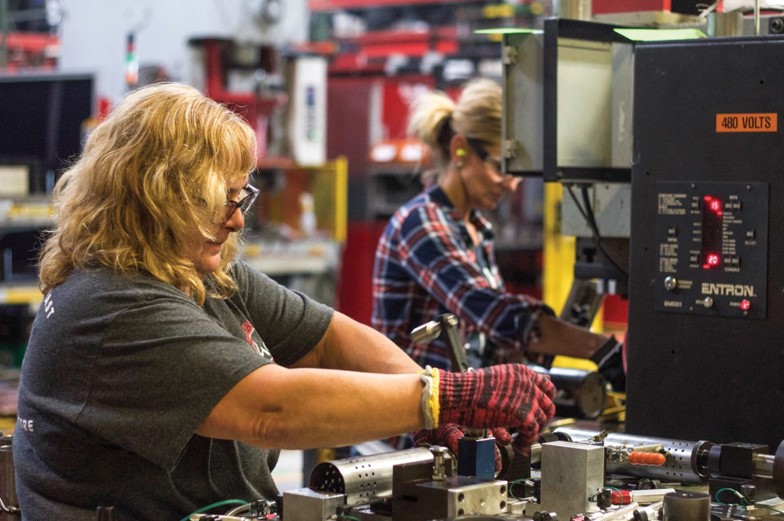Auto industry analysts remain optimistic with tool and die outlook
main text
Auto industry analysts remain optimistic with tool and die outlook

File photo courtesy of Middleville Engineered Solutions
The former Middleville Tool & Die earlier this year rebranded as Middleville Engineered Solutions following an investment from a metro Detroit private equity firm.
Setting aside all the turbulence from the UAW strike and ongoing macroeconomic factors, automotive analysts say there’s reason to remain optimistic for one sector of the industry that’s heavily concentrated in West Michigan.
Southfield-based industry consulting firm Harbour Results Inc. noted in its most recent survey that tooling slowed in the third quarter of this year as quote activity declined and backlogs stood at more than three months.
However, President and CEO Laurie Harbour sees new tooling opportunities on the horizon and particularly strong demand because of the shift to EVs, specifically the multitude of new EV models that automakers expect to introduce in the next three to five years.
“From the perspective of tooling itself … I can’t build the car without a tool for all the parts that it has, so I have to launch new tools for those while I’m also launching all of these ICE products that all the OEMs have,” Harbour told Crain’s Grand Rapids Business in a recent interview. “So, in a sense, it’s very good for the tool industry.”
The outlook comes amid a frothy time for the automotive industry, although the sector appears to be returning to some sense of normalcy after UAW members ratified their contracts following a prolonged strike against the Detroit 3.
With the high-profile contract dispute behind it, the automotive industry will finally gain some clarity about the future, which should reverberate through sectors like tool and die, said Mike Wall, executive director of automotive analysis at S&P Global Mobility in Grand Rapids.
“Once we do get the union negotiations in the rearview mirror, it’s going to be all eyes forward on all of these vehicle launches and, in particular, this EV migration,” he said.
Tool and die makers have dealt with supply chain disruptions, inflation and labor shortages like the rest of the manufacturing industry, and they face unique challenges such as price pressures that frequently have them competing with producers in China. But the dozens of new EV launches in the coming years could provide a massive lift for the firms that are positioning to capitalize on the market, Harbour said.
Harbour noted that some vehicle components currently stay the same between internal combustion engine (ICE) and EV models, contributing to the overall availability of work for tool and die makers and her firm’s favorable outlook. Additionally, Harbour believes the broader North American tooling industry has the strength and capacity to compete with China for tooling jobs.
“The shops have to fight for their own viability by improving their business. And the data shows us that they have not done everything that they can to improve their business,” Harbour said during a recent webinar. “Once they can do that, they can show data to the OEMs and their customers about why we should make tools here.”
“I’ve been saying for over a year now: I’m very bullish about the tool forecast for the automotive industry, and I’ll tell you I’m still very bullish,” Harbour added.

Harbour Results Inc.
Harbour
What the future holds
The fate of the tool and die sector weighs on the manufacturing sector locally in West Michigan. According to data from the Bureau of Labor Statistics, the Grand Rapids-Wyoming metro area ranks third nationally for the number of jobs (1,800) in the tool and die sector, behind Detroit and Chicago. Local workers in tool and die make an average wage of $28.51 per hour and an average annual wage of $59,290.
Michigan also has the most tool and die jobs of any state and is home to the highest industry concentration nationally, per BLS data.
Harbour views this region as “a tremendous manufacturing base” tied to the automotive industry with tooling, molding, stamping and other capabilities.
Still, like many lower-tier automotive suppliers, tool and die companies will be wrestling with a great deal of complexity in the transition from internal combustion engine vehicles to battery electric vehicles, Wall said. That shift is leading some companies to consider their future and place within the automotive industry.
“What you’re going to see with tool and die is probably similar to what we’re going to see with just production suppliers as well. You’re going to see some companies really kind of assess the landscape,” Wall said. “After going through COVID and these three years of somewhat chaos, where do they see their position in the industry going forward?”
Likewise, Harbour said the strikes and ongoing macroeconomic challenges have caused some strain for a particular subset of the tooling industry.
“’I’m very concerned about what the long-term effect of the strike will be on some of these smaller, family-owned, 100-person or 50-person shops,” Harbour said.
* Source : https://www.plasticsnews.com/news/auto-industry-analysts-remain-optimistic-tool-and-die-outlook
* Edit : HANDLER
- PreviousNovember European recycled resin prices vary, demand subdued 23.12.20
- NextRecycling of PET thermoforms needed for circular economy 23.11.19
